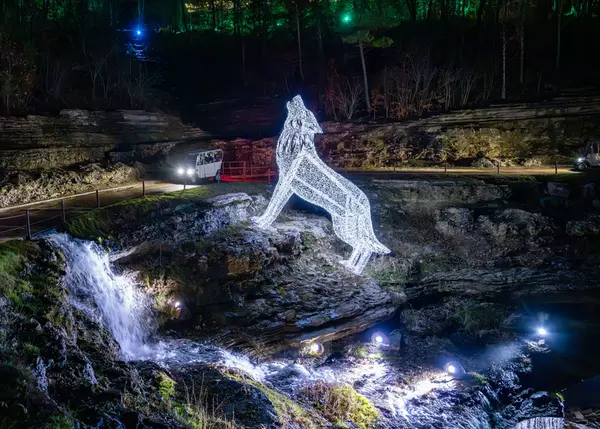Kansas City-area residents want to get closer to the Missouri River as a place to live, work and play. But are its extremes too unpredictable?
The inaugural “river goal” kicked out of CPKC Stadium last summer by Kansas City Current superstar Temwa Chawinga marked a new type of interaction between the metro and the country’s longest waterway.
The same day that Chawinga kicked the soccer ball out of the stadium and into the river, the Kansas Department of Health and Environment issued a stream advisory, warning residents to stay away from the Missouri River “due to upstream flooding and bypasses of untreated sewage in Iowa and Nebraska,” possibly elevating levels of “E.coli bacteria and other contaminants.” And about a week later, just following Independence Day, the U.S. Coast Guard temporarily shut down all Missouri traffic on the Big Muddy due to upstream flooding.

The new $117 million CPKC Stadium, a joint venture headed by the Current’s ownership group, which includes Brittany and Patrick Mahomes, is in an area along the river known as the Berkley Riverfront Park near the Bond Bridge. Near the stadium, plans for an estimated $1 billion in new commercial space totaling two million square feet over the next 10 years, as well as 480 apartments, are in the works. The Port KC-approved project will join the 410 units and Origin Hotel already in the area. It’s not just the Berkley Riverfront strip. Up and down the Missouri River, interested parties are wanting to invest in more buildings and boating.
The Kansas City metro seems to be collectively realizing that we live along, and are divided by, the country’s largest river. Entities increasingly want to capitalize on the Missouri’s wonder and power, as have other river-facing towns. But even a short steamboat history lesson reveals that the river’s legendary vessel-eating volatility, propensity to flood over its banks and seasons of drought could make some of these dreams difficult. Billions of dollars and plenty of high hopes revolve around future engagement with the Missouri, but will the Big Muddy play along?
Enormous Infrastructure Required

c. 1935. Photography courtesy of Kansas City Public Library.
The Missouri River we know today acts a lot differently than in the first part of the 20th Century.
From the 1930s to the 1960s, decades of super-scale earth-moving projects, led by the U.S. Army Corps of Engineers, were needed to channel the river. Six dams during that period were constructed in the Missouri River’s upper regions.
Before the dams, devastating floods, such as the 1951 flood, considered one of the worst, saw 573,000 cubic feet of water per second flow through KC. The flood caused $950 million in damage, without inflation factored in, and is blamed for 17 deaths.
Kansas City Downtown Airport–Wheeler Field (MKC), a city-owned non-commercial facility, is a multi-flood survivor. Surrounded on three sides by the river, MKC opened in 1927. The facility was once the Kansas City Municipal Airport and the headquarters of long-ago defunct legacy carrier Trans World Airlines from the 1930s through the 1960s.
“The municipal airport nestles behind the Missouri River levees, and passengers sometimes wonder if they are going to drop into the stream,” wrote Richard Baumhoff, a longtime St. Louis Post-Dispatch reporter in the 1951 book The Dammed Missouri Valley.
For the curious, you can see for yourself, courtesy of dozens of private pilots who have posted MKC cockpit landing videos on YouTube.
Although water from the river did not reach MKC’s runways, other nearby airport facilities succumbed to flooding. The destruction of TWA assets at an airfield there led to the eventual relocation of the area’s main commercial facility to the current Kansas City International Airport’s location. Despite its floodplain status, MKC officials like to boast it has never been submerged. The field is not only surrounded by massive levees overseen by the Army Corps but also elevated on a plateau.
The situation is sturdy enough for international advertising firm VML Corp. to house one of its headquarters out of rebuilt MKC terminals and for Taylor Swift to regularly fly in and out of for Chiefs games.
“It’s a good insurance policy that we have,” says Melissa Cooper, KCMO’s Director of Aviation, of the giant levees that surround the airport, reportedly built to withstand a 500-year flood.
Where It All Begins

The 2,315-mile Big Muddy starts in Montana’s high country, formed by the confluence of the Jefferson, Madison and Gallatin rivers. Missouri Headwaters State Park in Montana, near an area called Three Forks, marks the spot.
“If you floated downstream in an inner tube, you would reach the Gulf of Mexico in 2.5 months,” reads a sign in a modest clearing where the Missouri River begins at just over 4,000 feet above sea level, surrounded by mountains in the middle of Montana. Willful kayakers take that as a challenge every year.
At the end of April, when the ice starts to really melt, you can clearly see where the three rivers converge with calm certainty, forming North America’s longest waterway.
The Upper Missouri, as it’s called in these parts, bears little resemblance to what you might experience in North Kansas City. For one thing, you can see through it, and the water sparkles in the sunlight like magic.
From Three Forks, the river cuts north through high prairie land, making it within 100 miles of the Canadian border. There, the river changes course, curving toward the southeast, cutting into the rocky landscape. The river then transitions into Fort Peck Lake, a massive manmade lake created by the U.S. Army Corps of Engineers that has more than 1,500 miles of shoreline, longer than the California coast.
The next dam in the Corps’ Missouri River system is Garrison, by Riverdale, North Dakota. Known as Lake Sakakawea, it is the third-largest manmade lake in the United States by volume, behind Mead and Powell. Just north of Pierre, South Dakota, is the third mega-reservoir along the Missouri River, the Oahe Dam. It sits between the state capital and the Cheyenne River Reservation, which lies on the lake’s northern border.
Fort Peck, Garrison and Oahe, along with the smaller dams further downstream (Big Bend, Fort Randall and Gavins Point), have a total capacity of 73 million acre-feet of water when full. One acre-foot of water equals one foot of water spread over one acre. That means at full capacity, the dams have enough water to put nearly two feet of water over the entire state of Missouri.
The dams and waterway are the center of the Missouri River Basin, a geographic footprint of 529,350 square miles surrounding the river. As the river flows toward the southeast, which spans parts of ten states and two Canadian provinces, it narrows from Omaha through the KC metro.
The Levees
A $529-million multi-year improvement project to the local levee system is nearing its completion. This system is protecting lives and billions of dollars in KC-area properties. To grasp the levees’ importance, you must understand what’s upstream.
Since the waterway flows in a southeasterly direction, the KC metro is downstream from the river’s snow-melt source in the Rocky Mountains, as well as several tributaries along the way. The six Army Corps dams in Montana and the Dakotas combined boast a storage capacity exceeding both lakes Mead and Powell, together, in the Southwest.

Any upstream water eventually makes its way downstream, and to get a better idea of how the system works, Eileen Williamson, a spokeswoman for the Corps of Engineers, tells people to visualize a champagne tower like you might see at a wedding. As the water flows down through the system, it fills up champagne flutes (reservoirs) along the way, each prior overflow continuing into the next.
Meanwhile, a storm can break out pretty much anywhere, anytime along the Missouri, adding to the cubic feet-per-second water stream that is always moving forward.
An Extreme Forecast

Marinas, docks and other proposed structures along the Missouri need approval from the Army Corps, which is responsible for flood control, navigation, hydropower, irrigation, water supply, recreation, fish and wildlife, and water quality on the Big Muddy.
Marina-like structures that are being proposed along the river are not without precedent, says John Remus, chief of the Corps’ Omaha-based Missouri River Water Basin Water Management Division.
Remus was in the area last Halloween for Corps officials’ annual Fall Public Meetings on Missouri River Mainstem Reservoir Regulation. Everyone who’s interested in Big Muddy development must realize the river’s penchant for extreme weather, Remus stresses. “If you look at [the data] very carefully, you’ll realize we’ve had 11 of the 12 highest runoff years in the last 50 years, over a 125-year record,” Remus says. “Is that a trend? Maybe, maybe not. And we have had large hydrologic events that caused some very localized flooding that 20 years ago would have been considered rare.”
In 2019, the runoff spike was extreme, totaling just over 60 million acre-feet of water. The weight of that much water compared to everyday human-life measurements is brain-stretching and hard to imagine—until you see what can happen. Video of the failed Rapidan Dam in Minnesota last summer shows a house helplessly falling into the river as the nearby bank eroded.
Despite that frightening scene, Remus says he’s not “alarmed” that a similar catastrophic event could happen to the Missouri River’s dams, as they were designed to handle runoff from massive amounts of snowpack in the Rockies. Snowpack runoff accounts for about 50 percent of the high water you see running in the summer months.
What the Army Corps also tries to accommodate—but is powerless to predict—are torrential rains along the way. Upstream storms on a tributary can significantly add to the Big Muddy’s force. In 2019, it was a combination of flooding between the Missouri and Platte rivers, among others, that led to parts of a submerged Interstate 29 being closed for days.
Don’t Forget The Droughts

The Missouri River is not immune to droughts either. If it’s not a landscape-changing destructive flood concerning river watchers, it’s prolonged drought and periods of water scarcity.
On a dry December day, one can walk out onto a sandy riverbed for dozens of feet before hitting the flowing channel below Riverside’s E.H. Young Park.
While the Army Corps’ research shows increasing high-water events, it also reveals that, despite those occurrences, 77 percent of the Missouri basin was considered in some stage of drought at various points last year.
“Runoff into the reservoir system was below average for the month of January, and conditions across the basin remain dry,” Remus says. “With the below-average plains and mountain snowpack, we are forecasting a below-average runoff year for the basin.”
A May update revealed more of the same. About half of the entire Missouri River Basin was considered in moderate to extreme drought conditions, with 29 percent of the area considered “abnormally dry,” according to the multi-agency National Integrated Drought Information System.
“Drought is expected to persist or develop across portions of all the Missouri River Basin states, with the entirety of North Dakota and Nebraska expected to be in drought,” according to the NIDIS.
All of this spells for a Big Muddy that gets low enough between floods to make people concerned. During these times, worries are heightened more when people talk of piping water to dry communities further away from the Missouri, like drought-plagued western Kansas.
340 Miles in 86 Hours

Celebrating its 20th anniversary in July, the annual MR340 kayak and canoe race on the Big Muddy attracted some 500 paddlers.
“The Missouri River belongs to all of us,” says Steve Schnarr, who works for River Relief, the nonprofit that puts on the 340-mile race every year. The belief that the river is for everyone was the genesis of the race, Schnarr says.
“One of the real benefits of this race is that we have shown and proven that this is also our river,” says Schnarr, who is the MR340 race director. “We share this river with the navigation industry. We share this river with work barges and the sand dredge industries that require the river. But it’s the general public’s river, and you don’t have to get a permit to go paddling on the Missouri. You can just do it.”
The race starts at Kaw Point Park, where the Kaw merges with the Missouiri. River Relief’s mission is to promote the care and restoration of the river through education, stewardship and recreation.
Every year, either going it alone or in groups, paddlers descend on Kaw Point Park in all sorts of water-bound contraptions, some that look like they’re right out of a Mad Max film. The race ends hundreds of miles down the river in St. Charles. It takes most racers at least two days to finish, and there is an 86-hour cut-off.
“One of the best ways to inspire people to keep the river healthy is to provide them with a sense of ownership through exposure,” Schnaar says. The race brings a brief festival-like atmosphere to Kaw Point, with vendors and food trucks, every July for a few days.
While there are eight required stopping points, the journey is exhausting, and if even if you’re an experienced kayaker like Tom Bailey, co-owner of KC Kayak and Canoe, you might still get so tired that you hallucinate, just like he did when he saw the Virgin Mary during one of the multiple MR340 races he has participated in.
“You look at the clouds and you see stuff,” Bailey says.
Balancing Pleasure With History’s Warnings

Those who regularly stroll and run along Parkville’s English Landing Park’s trails are known as serious outdoor enthusiasts.
A favorite in the Northland area, the 68-acre outdoor centerpiece along the Missouri River hosts the occasional festival, soccer and baseball games, and a pretty constant flow of foot traffic. You can get very close to the river’s edge there.
Many ignored the “Do Not Cross” tape and “Area Closed Do Not Enter By Order of Parkville Police Department” signs posted on June 30 due to potential flooding. A few complained that the water wasn’t close to approaching the 27-foot height level considered a flood danger in Parkville. Eleven citations were issued for crossing police barriers.
“It’s a funny thing,” says Kevin Chrisman, Parkville Police Department’s police chief. “Some people feel like since they live in this county, or nearby, that the signs aren’t for them.”
But they are. Chrisman tries to remind people that English Landing, which replaced a landfill in 1987, actually serves as a natural flood buffer to Parkville’s historic downtown. If everyone stays away from the park during potential flooding, the city doesn’t lose cars or lives, he says.
Chrisman clearly remembers the community’s anxiety in 2011 when the river hit 32.6 feet and English Landing was under water for weeks.
Drawn to the Water
“We need to engage the river because people want to be close to it, whether they’re just looking at it or whether they’re on it,” Riverside Mayor Kathy Rose says of her town, Parkville’s downstream neighbor.
On the same day last year when citations were written in Parkville, Riverside’s E.H. Young Riverfront Park, next to the Argosy Casino and Hotel, was busy. The pickleball courts were active, skateboarders were doing tricks and people were walking along the park’s trails.
The once mainly industrial and sleepy town of Riverside has recently procured several high-profile developments. The Current’s ownership, who already have a practice facility in the city, recently started construction on the 2,000-seat FIFA-certified Riverside Stadium, a 35,000-square-foot training center with 12 grass and turf pitches. That’s on top of a $120-million 15,000-seat amphitheater approved by the city’s aldermen last year.
Rose wants recreation closer to the water as well.
“Our next move is to put in a marina,” she said last year, having heard residents’ interest in excursion-boat travel to Current games. The team’s existing Riverside practice facility is a short drive from E.H. Young. Rose sees the marina doubling as a dock for excursion boats to CPKC Stadium and a place for kayakers to easily enter and exit the water, as there aren’t many places to do so currently. “It’s fast-moving and can be dangerous if you’re not careful,” Rose says of the Missouri. “But there are a lot of experienced people who would love that opportunity.”
Only time will tell if the river’s promise of both business and recreation will be realized.
The post Kansas City-area residents want to get closer to the Missouri River as a place to live, work and play. But are its extremes too unpredictable? appeared first on Kansas City Magazine.
Categories
Recent Posts










GET MORE INFORMATION

